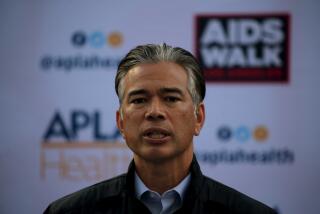THE TIMES 100 : THE GIANTS : An HMO in the Pink : TakeCare Expects to Survive the Health Shakeout
In the crowded, changing marketplace for health maintenance organizations, TakeCare Inc. is largely betting the future on its doctors. So far, the strategy has worked well.
Concord-based TakeCare ranked No. 4 on The Times Growth 100 list of public companies in California with the sharpest sales gains. The company, which owns HMOs in California, Colorado, Ohio and Illinois, made a 110% leap in sales for 1992, to $616 million.
In an industry stressed by tough competition and consolidation among companies, not to mention the upheaval that may come as the Clinton Administration proposes a nationwide medical coverage plan, TakeCare President R. Judd Jessup expects his HMOs to survive and expand.
“TakeCare . . . looks like it’s going to be a long-term player as we go through health care reform,” Jessup said.
Analysts and other observers largely agree with him. They credit much of the company’s success to its reputation for retaining doctors whose services are preferred by employers offering managed-care coverage.
TakeCare “has contracted with some of the more prestigious medical groups in the state,” said Joel M. Ray, a health care services analyst with Kidder, Peabody & Co. in New York.
TakeCare also was highly rated in the HMO Buyers Guide, published by HealthPlan Management Services, a subsidiary of John Hancock Mutual Insurance Co. The guide, an employers’ reference that ranks the quality of HMOs, named TakeCare as one of the top 10 in the United States in 1992. The guide studies the operations of more than 400 HMOs nationwide and all the HMOs serving the 55 largest metropolitan areas.
“They’re a very good, well-established HMO,” said Karen M. Richardson, director of marketing for the guide. “They were regionally based. Now they are going to be a very strong national HMO player.”
As Richardson notes, what was once a Northern California company now has a major market share throughout the state, as well as a strong presence in other states. Membership has risen to 550,000 from 233,000 in 1991, and sales have soared to more than $600 million in 1992 from about $200 million in 1989.
TakeCare was founded 15 years ago--a relatively long time in the young HMO business--as a subsidiary of Blue Cross of California. It became a for-profit corporation in 1988 when it was bought by a private investor group. TakeCare went public in March, 1991, and its stock is traded on the NASDAQ market system.
While TakeCare has grown the old-fashioned way--via company salespeople knocking on doors--most of its recent expansion has come through acquisitions.
In the summer of 1992, TakeCare bought 13 HMOs from Indiana-based Lincoln National Corp. It kept the four largest and most lucrative of them and sold the rest. The acquisitions brought in almost 300,000 new members and a geographically diverse physician network accessible to 96% of California’s population. The Lincoln HMOs also opened out-of-state markets for TakeCare.
Just last month, the company merged with Comprecare Inc., picking up 178,000 members in Colorado. This has made TakeCare of Colorado the largest HMO in the state--surpassing industry leader Kaiser.
But TakeCare has been careful to acquire companies not just for their rolls, but also for the quality of their subscribing physicians. It goes to more trouble than most other HMOs to make regular surveys of subscribing companies, inviting comment on the doctors in their plan. Then TakeCare gives that feedback to the doctors. Physician groups that please employers--and their workers--are a major competitive advantage for any HMO.
One way large companies strive to reduce medical coverage costs is by limiting the selection of HMOs they offer employees. As a result, large employers favor HMOs with extensive rosters of well-regarded doctors and large geographical bases to serve workers in far-flung offices.
As businesses winnow their HMO choices, some health care suppliers are likely to disappear.
In California--where about a third of the population uses HMOs--the current 50 HMOs are likely to drop to about a dozen in the years ahead, according to industry observers. Jessup said he expects there could be as many as 20, “but that’s just a number out of the air.” No matter: He expects TakeCare to be one of the survivors.
“It may be a platitude,” Jessup said, “but we really do try to hang our hat on member satisfaction.”
More to Read
Inside the business of entertainment
The Wide Shot brings you news, analysis and insights on everything from streaming wars to production — and what it all means for the future.
You may occasionally receive promotional content from the Los Angeles Times.










